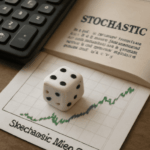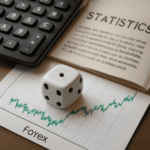Asset pricing is a core component of modern finance, influencing investment strategies, risk management, and derivative valuation. However, financial markets are inherently uncertain and driven by complex dynamics, making accurate pricing a challenge. To address this, economists and financial mathematicians have turned to stochastic models, which incorporate randomness into asset price dynamics.
Behind these models lies a robust mathematical framework that enables the precise analysis and simulation of financial variables. This article explores the mathematical foundations of stochastic models in asset pricing, including probability theory, stochastic processes, differential equations, and key theorems that support the modeling of assets in uncertain markets.
What Are Stochastic Models in Asset Pricing?
A stochastic model in asset pricing is a mathematical system that represents the behavior of asset prices using variables that evolve over time with inherent randomness. Unlike deterministic models that assume known and fixed outcomes, stochastic models reflect the uncertainty and volatility present in real-world financial systems.
Why Use Stochastic Models?
-
Financial assets do not follow linear paths.
-
Prices are influenced by random events, market news, and macroeconomic variables.
-
Stochastic models allow for risk-neutral valuation, simulation, and forecasting.
Probability Theory: The Foundation of Stochastic Modeling
Probability Spaces
A probability space is defined by the triple \((\Omega, \mathcal{F}, P)\), where:
In finance, this structure is used to model uncertainty about future asset prices.
Random Variables and Distributions
A random variable maps outcomes from \(\Omega\) to real numbers. In asset pricing:
-
Returns are modeled as normally or lognormally distributed variables.
-
The distribution of returns affects risk and valuation.
Conditional Expectation and Martingales
A martingale is a stochastic process \(X_t\) such that:
E[Xt+1∣Ft]=XtE[X_{t+1} | \mathcal{F}_t] = X_t
This concept is central to risk-neutral pricing. Under the risk-neutral measure, the discounted asset price is modeled as a martingale.
Stochastic Processes in Asset Pricing
Brownian Motion (Wiener Process)
A continuous-time stochastic process \(W_t\) is called a Brownian motion if:
-
Increments are independent
-
Paths are continuous but non-differentiable
Brownian motion is used to model the random shocks in financial markets.
Geometric Brownian Motion (GBM)
The most widely used model for stock prices:
dSt=μStdt+σStdWtdS_t = \mu S_t dt + \sigma S_t dW_t
Where:
GBM ensures that prices remain positive and is the basis for the Black-Scholes model.
Mean-Reverting Processes
For interest rates and commodities, Ornstein-Uhlenbeck or Cox-Ingersoll-Ross (CIR) processes are used:
drt=a(b−rt)dt+σrtdWtdr_t = a(b – r_t)dt + \sigma \sqrt{r_t} dW_t
These models reflect the tendency of variables like interest rates to revert to a long-term mean.
Stochastic Differential Equations (SDEs)
Definition
SDEs describe how variables evolve over time with deterministic and stochastic components.
General form:
dXt=μ(Xt,t)dt+σ(Xt,t)dWtdX_t = \mu(X_t, t) dt + \sigma(X_t, t) dW_t
Solutions to SDEs represent the path of an asset price under stochastic dynamics.
Ito’s Lemma
Key to working with SDEs, Ito’s Lemma is the stochastic analog of the chain rule. For a function \(f(t, X_t)\):
df=partialfpartialtdt+partialfpartialXtdXt+12partial2fpartialXt2σ2dtdf = \frac{\\partial f}{\\partial t} dt + \frac{\\partial f}{\\partial X_t} dX_t + \frac{1}{2} \frac{\\partial^2 f}{\\partial X_t^2} \sigma^2 dt
Ito’s Lemma is used to derive pricing formulas and transform variables in asset pricing models.
Risk-Neutral Valuation and Measure Theory
Real-World vs Risk-Neutral Measure
Under the real-world measure \(P\), asset prices reflect real expectations. Under the risk-neutral measure \(Q\):
-
All assets grow at the risk-free rate
-
Discounted asset prices become martingales
This transformation simplifies the pricing of derivatives and is central to no-arbitrage theory.
Girsanov’s Theorem
Allows the change from measure \(P\) to \(Q\) by adjusting the drift of the Brownian motion:
dWtQ=dWt+θdtdW_t^Q = dW_t + \theta dt
Where \(\theta\) represents the market price of risk. Girsanov’s Theorem underpins risk-neutral pricing in stochastic environments.
The Black-Scholes Model: A Stochastic Application
Assumptions
-
Stock prices follow GBM
-
Markets are frictionless and arbitrage-free
-
Constant volatility and interest rate
Derivation
By applying Ito’s Lemma to a portfolio combining a stock and option, the Black-Scholes PDE is derived:
partialCpartialt+rSpartialCpartialS+12σ2S2partial2CpartialS2=rC\frac{\\partial C}{\\partial t} + r S \frac{\\partial C}{\\partial S} + \frac{1}{2} \sigma^2 S^2 \frac{\\partial^2 C}{\\partial S^2} = r C
Solving the PDE gives the closed-form solution for European call and put options.
Advanced Stochastic Models in Asset Pricing
Stochastic Volatility Models
E.g., the Heston model, where volatility follows its own stochastic process:
dSt=μStdt+vtStdWt1dS_t = \mu S_t dt + \sqrt{v_t} S_t dW_t^1 dvt=κ(θ−vt)dt+ξvtdWt2dv_t = \kappa(\theta – v_t)dt + \xi \sqrt{v_t} dW_t^2
Accounts for volatility clustering observed in real markets.
Jump-Diffusion Models
E.g., Merton’s model, which adds jumps to the GBM framework:
dSt=μStdt+σStdWt+JtdNtdS_t = \mu S_t dt + \sigma S_t dW_t + J_t dN_t
Models sudden market events like earnings surprises or crashes.
Numerical Methods for Solving Stochastic Models
Euler-Maruyama Method
Discretizes SDEs for simulation:
Xt+Δt=Xt+μ(Xt,t)Δt+σ(Xt,t)ΔWX_{t+\Delta t} = X_t + \mu(X_t, t)\Delta t + \sigma(X_t, t)\Delta W
Monte Carlo Simulation
-
Simulates thousands of price paths
-
Used in pricing path-dependent options and for risk analysis
Finite Difference Methods
Solves PDEs like the Black-Scholes numerically on a grid.
Practical Implementation
Tools and Languages
-
Python (NumPy, SciPy, QuantLib)
-
R (sde, fGarch)
-
MATLAB
-
C++ (for high-frequency trading applications)
Industries Using These Models
-
Investment banking
-
Hedge funds
-
Risk management firms
-
Insurance and actuarial science
Challenges and Limitations
Model Risk
Incorrect assumptions or miscalibrated parameters can result in mispricing.
Complexity
Requires high-level mathematical and computational skills.
Market Imperfections
Real markets feature jumps, illiquidity, transaction costs—factors often omitted in theoretical models.
The Future of Stochastic Asset Pricing
Machine Learning Integration
Combining stochastic models with AI improves adaptive learning and parameter estimation.
Quantum Finance
Quantum computing may eventually solve stochastic systems more efficiently, revolutionizing real-time pricing.
Real-Time Risk Management
Firms are deploying stochastic engines for dynamic hedging, real-time VaR, and intraday portfolio analysis.
Stochastic models provide the rigorous mathematical backbone needed to navigate the uncertainty of asset pricing. From Brownian motion to jump-diffusion and stochastic volatility, these models enable more accurate valuation, risk management, and strategic investment.
Understanding their mathematical foundations is essential for financial analysts, quants, and researchers seeking to operate at the cutting edge of modern finance. As technology evolves and markets grow more complex, the role of stochastic mathematics in asset pricing will only deepen, shaping the future of global finance.


